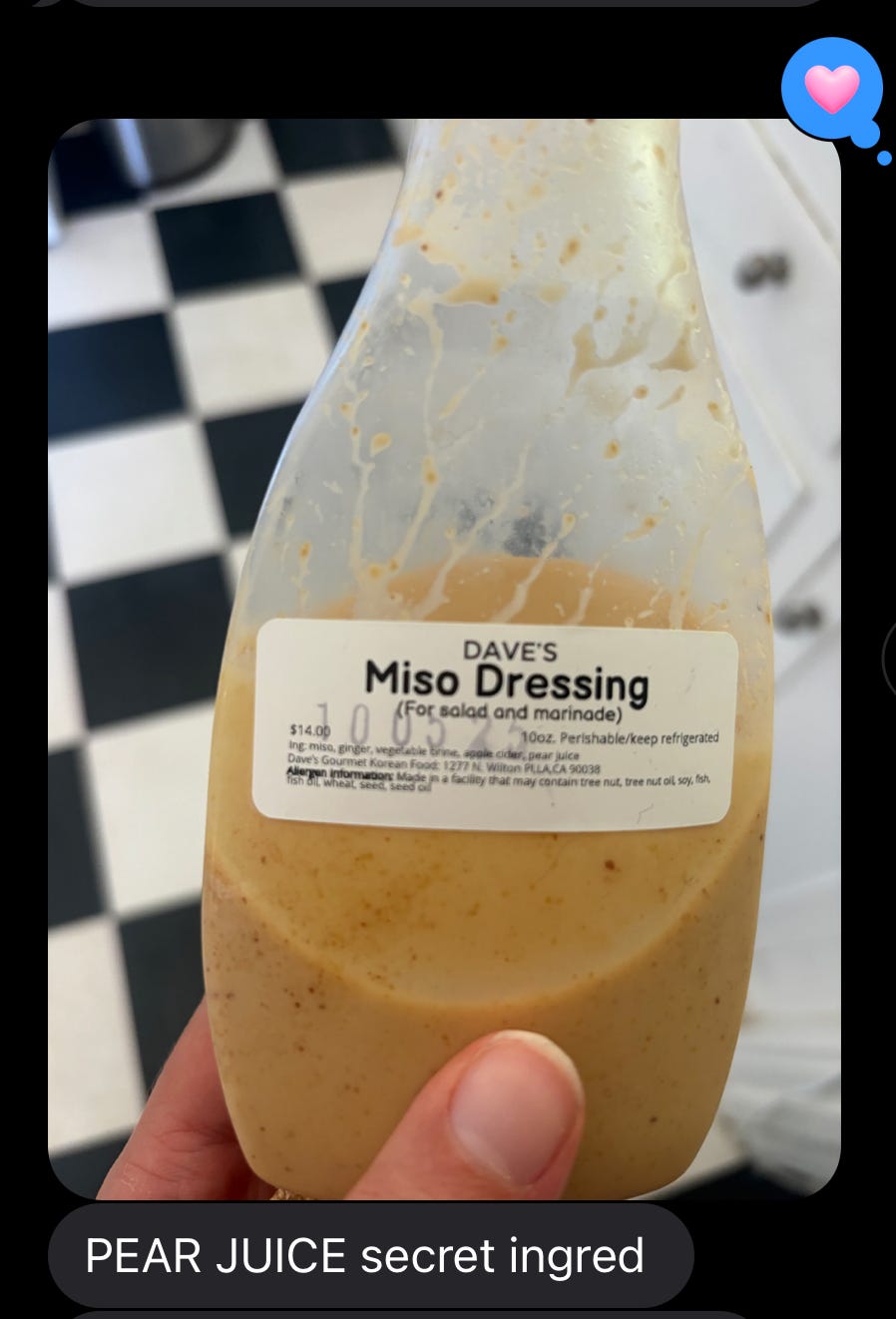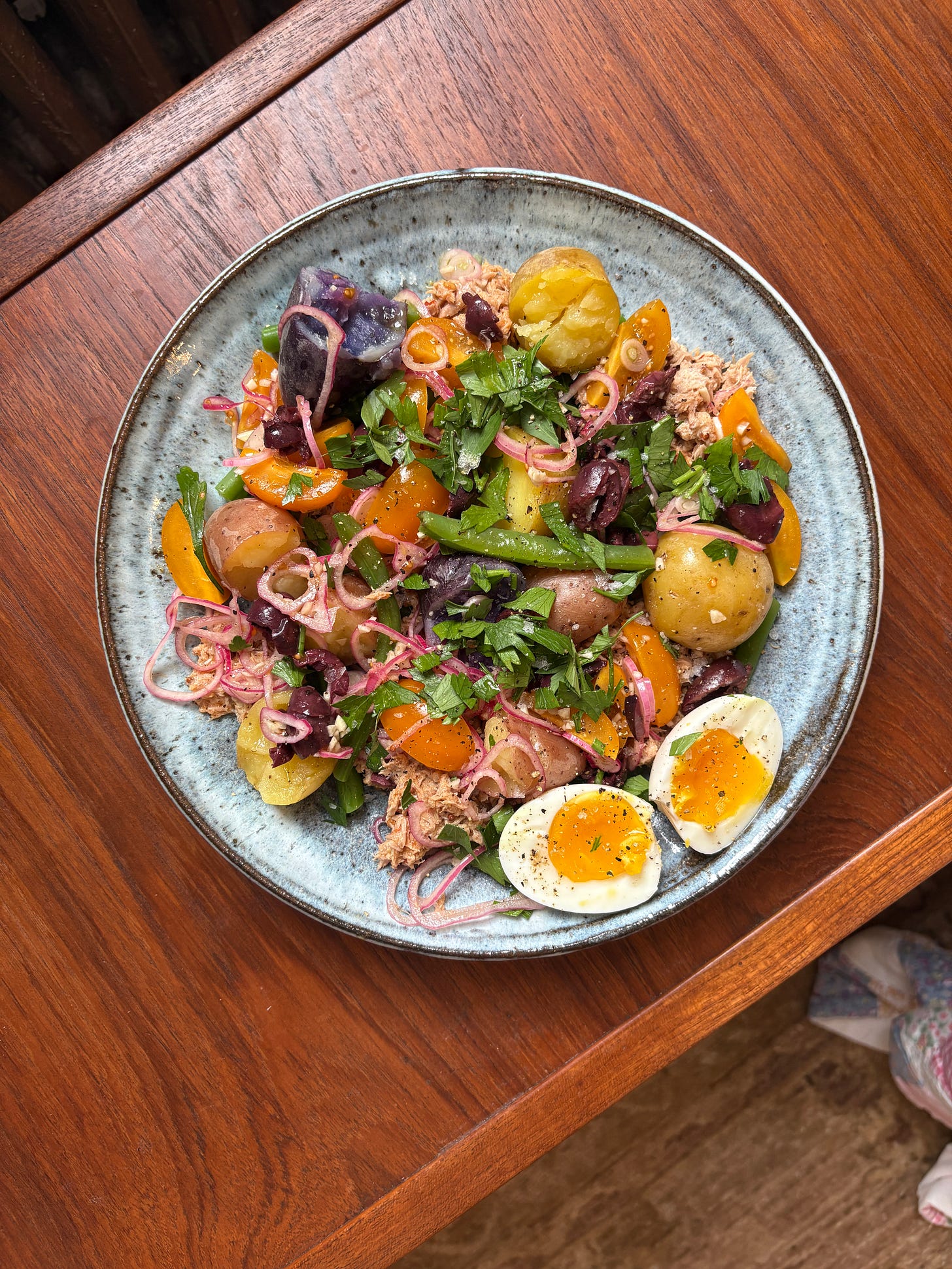A salad's center of gravity
Pear-miso-ginger / April Bloomfield's carrot-avocado-orange / saffron
I’ve let you all down. Despite being a “true poster,” this is my first post in two months. I knew I needed to say hello before plunging into my new job (!) today. I’ve been planning on writing about salad dressings for some time, and today I’m sitting on the couch with as good an example of what’s been interesting me as any: a meat-dressed salad. By that I mean: a mix of cabbage, baby butter lettuce, and bias-cut sugar snap peas and cucumbers, mint and cilantro and sesame seeds, all fairly normally dressed in a fish sauce/lime situation. But the meat—slightly warmed up pork larb from a dinner party last night—is what makes it cohere. This afternoon, I at first microwaved the larb and shoved it to one half of a shallow bowl, thinking I would eat it as a separate entity from the salad that filled up the other half. Then I realized they wanted to be one—Chris helped me see this by simply throwing one on top of the other. The lingering seasoning from the larb, loosened from being nuked, further dressed the salad, and the little nodules of ground pork didn’t only sit atop the vegetables but weaseled their way into their nooks, becoming false peas inside the openings of the sugar snap pods. Unifying the salad in this way felt like the moment when Jodie Foster’s character in “Contact” realizes that the data the aliens have been beaming to earth is not just 2D pages of information, but ones that interlock into three dimensional data-cubes:
This post is about salad logic, specifically about salad dressings that are delicious, customizable, surprising, or that, like the meat-dressed salad, burst forth from unexpected components, and are not only visitations from outsider vinegars and oils. These dressings ground the salad and demonstrate that the dish’s path doesn’t have to start with what seem to be the “main” ingredients. All salads can have “Contact” moments; all salads can have centers of gravity that might not be the obvious ones. It is our job and joy to find them. (Sorry for mixing metaphors. I already made the below banner when I decided to reference Contact.)
Pear-miso-ginger dressing
I’ve always loved the carrot-ginger dressing that comes with Japanese restaurant salads. (In particular, I remember loving the one that came with lunch orders at this perfect spot in DTLA… I’d walk there during deep Covid as the Goodyear Blimp yawned overhead… the salad came with tuna sashimi… I would get a matcha mochi cookie and banana milk boba on the side… a very beautiful ritual.) I’ve made it a few times thanks to the general shape of this recipe, though I usually use actual shallot instead of onion powder and replace the EVOO with a neutral oil + some sesame oil stirred in at the end. The sesame flavor seems essential to me?
Recently I decided to further explore this genre of blended, produce-forward Japanese-ish dressings. I love how they end up feeling like the point of the salad and substantial enough to be the central ingredient. You can add vegetables to these dressings vs. the other way around, in other words. My friend Caroline, I remembered, really loves this pear-miso dressing she gets at a farmers market in LA (seems like it’s from this place); when my grocery store’s pears looked especially appetizing, I—someone who rarely buys fruit and, when she does, rarely eats it on its own—asked her to send me the ingredient list:
I decided to make my version with a full pear, playing the role of the carrot. One bonus of this is the pear is already sweet and you don’t have to add sugar!!
Here’s how to make it (though you’ll have to adjust depending on your taste):
Blend the following in a blender or Nutribullet-like appliance:
The flesh of one Bartlett (or similar) pear, chopped into big chunks
One heaping spoonful of white miso
A 2-to-3-inch segment of ginger, depending on your taste, peeled and cut once or twice
Two tablespoons rice vinegar (unseasoned)
One tablespoon soy sauce
~1/3 of a green chili, jalapeño or serrano or bird’s eye, depending on your spice preference (totally fine to leave this out, and don’t go overboard, as I once did while making this)
A splash of water
Three tablespoons neutral oil
Then, when you’re done blending, taste it and adjust—I’m simply remembering these ratios at my laptop. You might want to add a little salt, a little more vinegar, a little more water to loosen it if it’s too thick, etc. Then stir in an additional ~half tablespoon sesame oil. The reason for stirring it in after, I guess, is that it’s kind of a delicate oil? I think you could probably blend it with everything, but I never have.
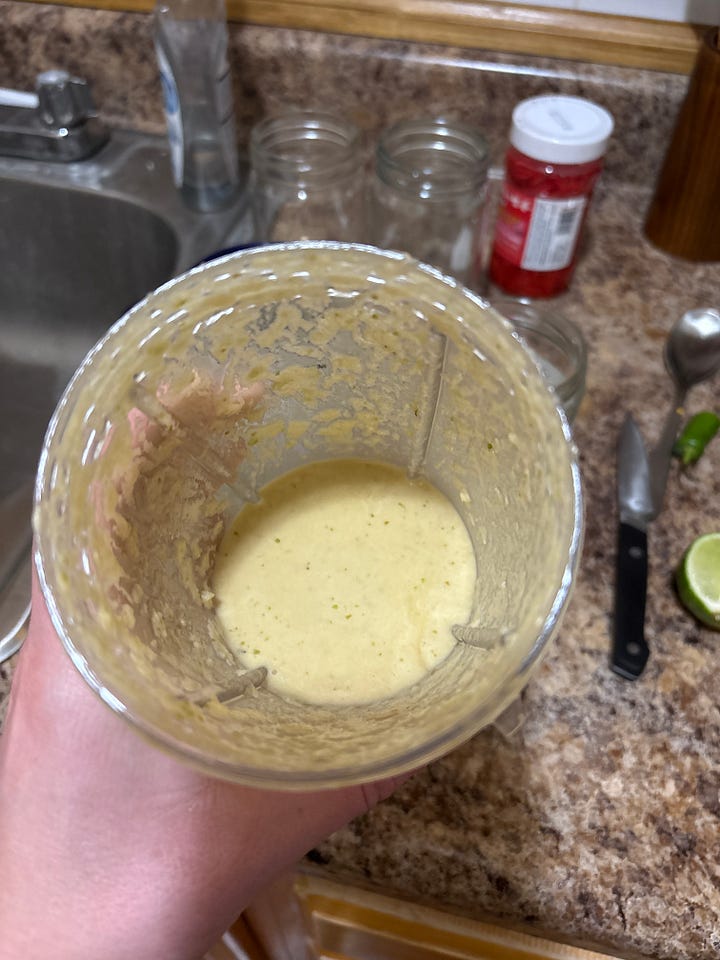
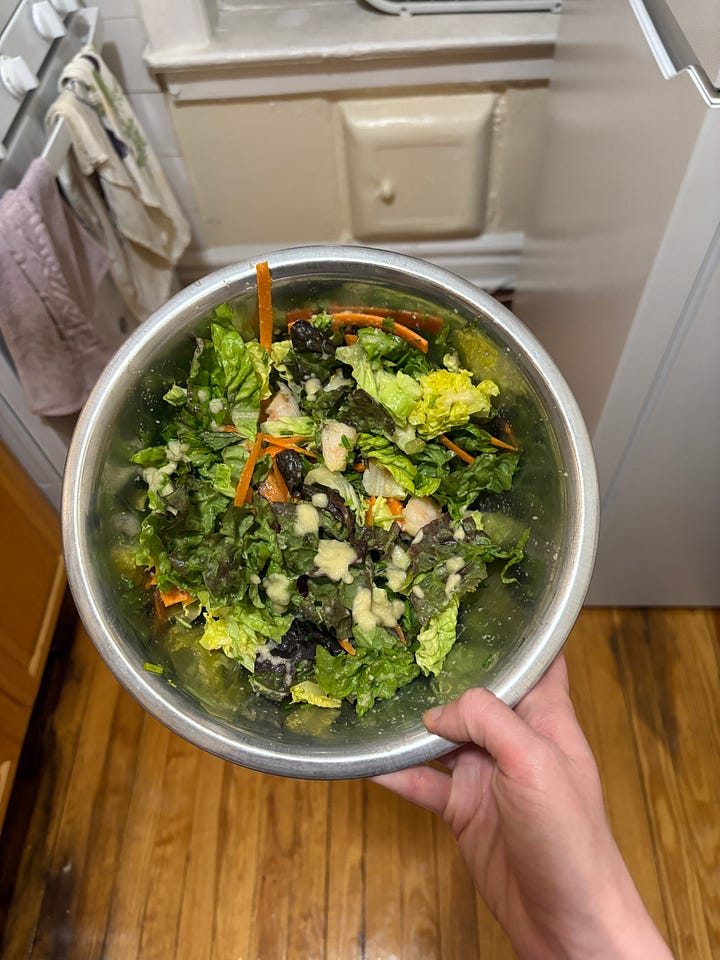
April Bloomfield’s carrot-avocado-orange salad
How about dressings that, uh, leak out of the ingredients as you’re preparing the salad? That is (partially) what happens in April Bloomfield’s carrot, avocado, and orange salad. I found this recipe through Frederico Ribeiro’s Instagram page. He’s my new strong fav; he used to be the sous chef at Per Se and now does the “snack” program (pastries and savories) at Té Company, the Taiwanese tea shop his wife Elena (!) Liao owns. I haven’t been there yet but this will change soon enough.
It’s a salad with just those three main ingredients. The carrots are steamed/roasted in the oven while covered in a spiced oil; the avocado is kept in big segments; the oranges are supreme’d. Technically the dressing starts in the most basic way possible—the avocadoes are tossed in lemon and olive oil, also to keep from oxidizing—but it’s rounded out with the juiciness of the orange and the post-oven carrot oil. The ingredients almost seem to dress themselves; it’s a recipe that encourages you to think ahead about roasting vegetables deliciously so that you don’t have to do very much to them or their oil afterward. Brilliant, weird, and—as Fred says in the video—texturally compelling. The cilantro atop is perfect.
I’ll keep this section short, because you can go ahead and click on the recipe and see what goes into this. When I made it, I beefed it up with arugula, since I thought the peppery notes would go well with all the sweetness and acid. I was right, and I will be making this again.
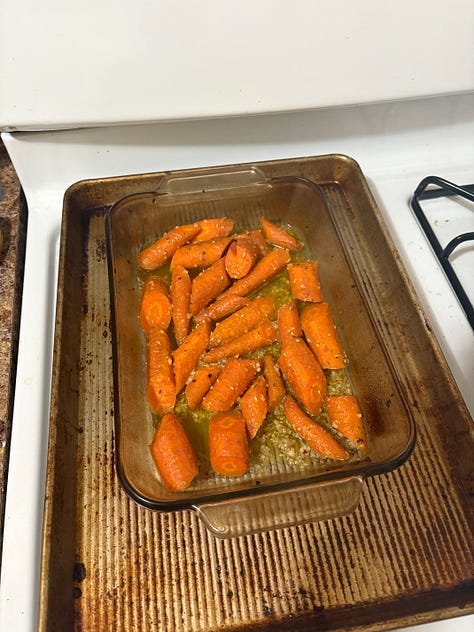
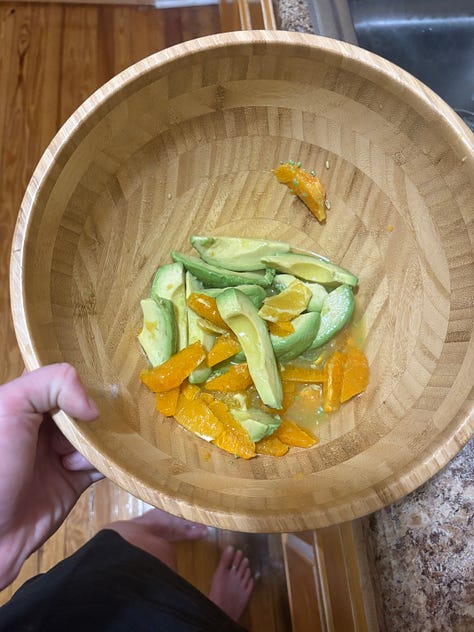

Saffron
Some dressings are sort of simple, but what if you thought about seasoning them ambitiously? I found a recipe in Sohla El-Waylly’s cookbook Start Here for “Citrus & Saffron with Bitter Lettuces”—a great order of ingredients and a beautiful dish, one that has pistachios, radicchio, endive, supremed cara cara oranges, and a somewhat simple vinaigrette with saffron. I loved that idea and made a similar version without following her recipe:
Radicchio, a sweet lettuce (baby butter lettuce here), supremed oranges
A vinaigrette with lemon juice, the juice from the orange corpses, EVOO, salt and pepper, and a tiny pinch of saffron bloomed over the smallest chunk of ice.
Serve it with something that sounds like it wouldn’t clash with saffron: in this case, spaghetti alle vongole <3
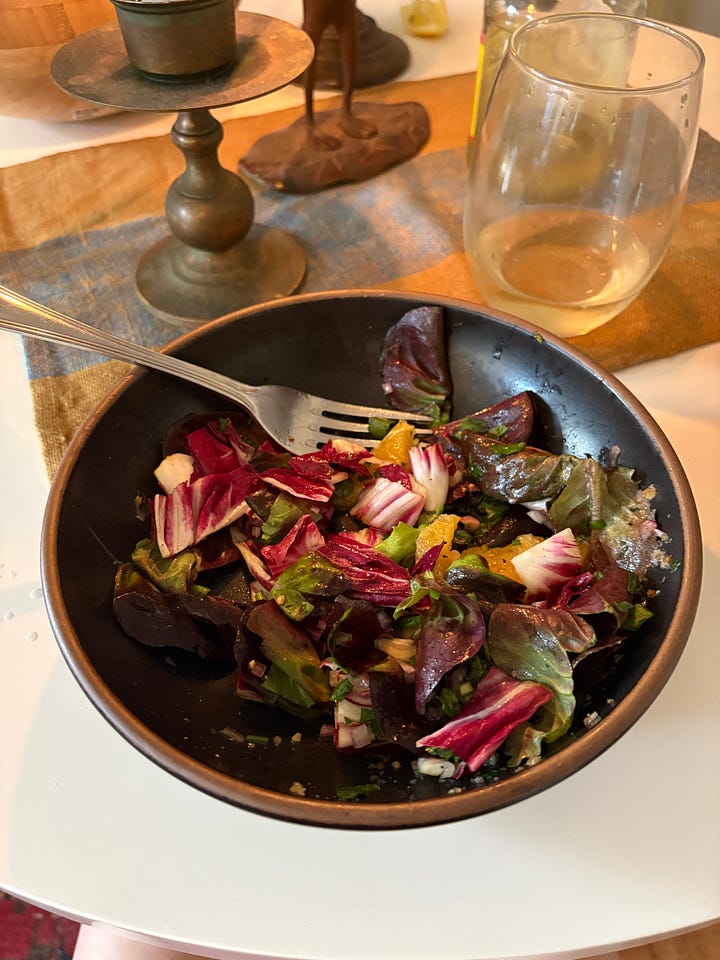
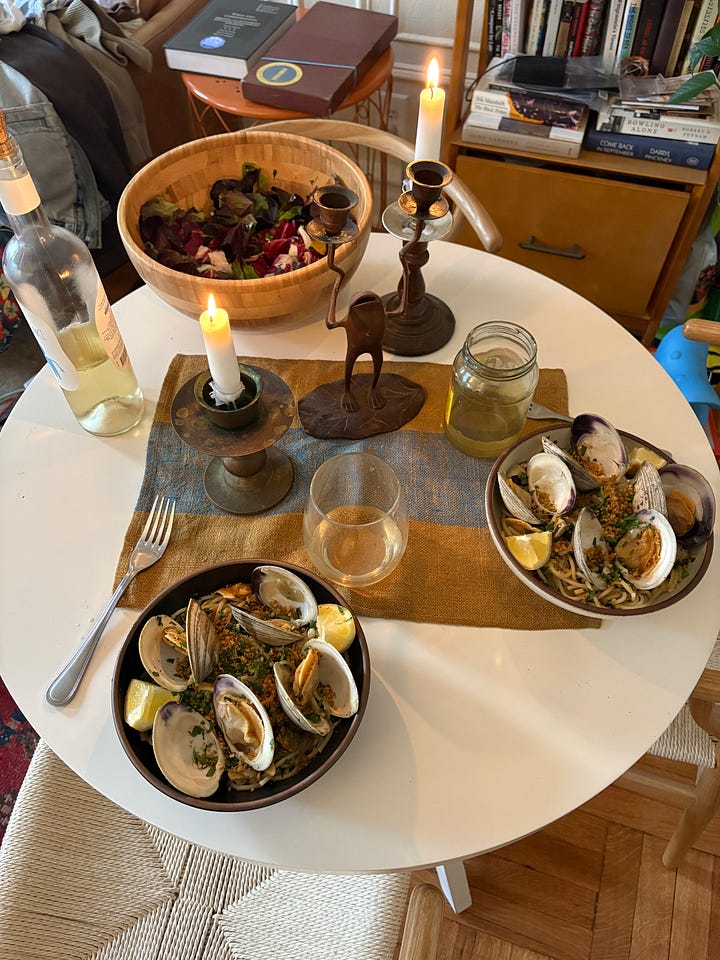
Nothing is really coming to mind, guys, that’s worth sharing. But would you like to see one more salad? It’s a tuna nicoise. It’s one of the more flawless things I’ve made recently. This had: rainbow potatoes; tuna mixed with two mustards, lemon, evoo, and calabrian chili; green beans; tomatoes and shallots marinated in red wine vinegar; kalamata olives; parsley; egg. My three main tips:
Really cook the potatoes. Cook them until you can rip them apart and reveal their creamy insides, which is not only fun but looks much better and craggier on the plate.
Build the dressing into and on top of the marinating tomatoes/shallots. I added some lemon, evoo, garlic, S&P.
Put your ingredients in the fridge as you go so they’re below room temperature, ideally somewhat cold, when you serve it. Or refridge the plate?
xoxo,
Elena





